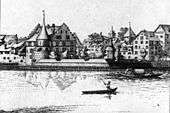Johann Balthasar Bullinger
Johann Balthasar Bullinger (30 November 1713, Langnau am Albis – 31 March 1793, Zürich)[1] was a Swiss landscape painter.


Life
Bullinger was born in Langnau am Albis, the son of Heinrich Bullinger, a clergyman.[1] He was a pupil of Johann Melchior Füssli and then of Johannes Simler, with whom he studied both painting and engraving.[1] He then went to Venice, carrying a letter of introduction to Anton Maria Zanetti, who introduced him to Tiepolo, in whose studio he worked from 1732 until 1735.[1] He first attempted historical painting, but then turned to landscapes,[2] painting his first works in that genre in Steinbrugg in 1736. In 1737 he worked as a portraitist in Neuenburg. He spent the years between 1738 and 1741 in Amsterdam,[1] where his work came under the influence of Dutch artists such as Both and Berchem.[2] Bullinger also created the ceiling and wall paintings of the Zunfthaus zur Meisen, a guild house and present faience museum that was built at the Münsterhof plaza in Zürich in 1757.
He died at Zurich in 1793.[2]
Etchings
He etched several plates in a free, painterly style; they include:[2]
- The Portrait of J. B. Bullinger; se ipse fec.
- A Frontispiece, with a number of Genii.
- Two Mountainous Landscapes, with figures.
- A set of fifty Landscapes; some from his own designs, and the others after J. F. Ermels and F. Meyer.
- A Head; after Le Brun; engraved for Lavater's Work.
References
- "Bullinger, Johann Balthasar". Historischen Lexikon der Schweiz. Retrieved 20 October 2013.
- Bryan 1886
Sources
